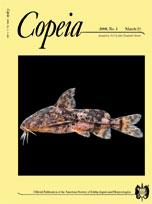Gaps in recent studies of hognosed pit vipers in the genus Porthidium have left researchers with an incomplete estimate of the evolutionary history of this group. Mitochondrial DNA sequence data from the poorly known P. hespere and additional Porthidium sequences obtained from GenBank were used to re-analyze the phylogenetic relationships of Porthidium. Using sequence data from the South American Porthidium, we also updated a previous molecular clock calibration based on the uplift of the Isthmus of Panamá, and utilized this updated calibration to evaluate the phylogeography of arid-adapted Porthidium. Results from Bayesian Markov chain Monte Carlo phylogenetic methods underscore the historical pattern of bi-directional dispersal into and out of South America within Porthidium, and place P. hespere as the sister species to P. dunni. The three species of arid-adapted Porthidium distributed across the Pacific coast of southern Mexico and northern Central America may have diverged in the late Miocene after the enlargement of the Río Balsas drainage following the formation of the Mexican Transvolcanic Belt and the volcanic uplifting across the Chiapan–Guatemalan highlands.
Debido a la ausencia de algunas especies en los estudios recientes de las nauyacas nariz de cerdo del género Porthidium, los investigadores no tienen una estimación completa de la historia evolutiva de este grupo. Se utilizaron nuevas secuencias de ADN mitocondrial de la poco conocida P. hespere y otras secuencias obtenidas de GenBank para reanalizar las relaciones filogenéticas de Porthidium. Usando secuencias de Porthidium sudamericanas, también se actualizó una calibración previa del reloj molecular basada en la elevación del Istmo de Panamá, y esta calibración actualizada se utilizó para evaluar la filogeografía de las especies de Porthidium adaptadas a la aridez. Los resultados de los métodos filogenéticos Bayesianos Markov chain Monte Carlo enfatizan el patrón histórico de dispersión bidireccional hacia y desde Sudamérica en Porthidium, y ubican a P. hespere como especie hermana de P. dunni. Las tres especies de Porthidium adaptadas a la aridez de la costa Pacífica del sur de México y norte de Centroamérica podrían haber divergido en el Mioceno tardío después del ensanchamiento del drenaje del Río Balsas que siguió a la formación del Eje Neovolcánico y la elevación volcánica de las tierras altas de Chiapas y Guatemala.





